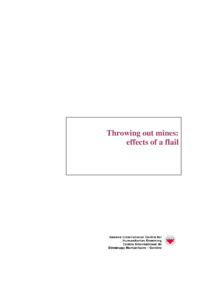Recent tests and trials on the clearance capability of flail machines have shown thatif machines are adequately operated and the operating environment is favourable, flails are able to achieve clearance rates approaching 100%1. However, some field operators have experienced clearance rates as low as 50-60%. An important reason for the discrepancy is that a proportion of aged mines have faulty detonation mechanisms. Having failed to detonate, some also remain apparently intact after flailing. When found by QA teams, these mines are reported as missed because examining their firing mechanism is time consuming and dangerous. The resulting under-representation of clearance capability suggests that flail machines should only be used as ground preparation for subsequent demining, a conclusion that we believe to be inappropriate.
To satisfy the requirements of statistical analyses, tests on clearance capability of
flail machines require a large number of mines. Real mines are scarce, mine mimics are expensive, and tests tend to use too few mines to support statistical analysis. Despite such resource constraints, a continued effort to test machines is desirable and should be prioritized. Clearly, any study designed to explore the proportion of mines that are initiated or broken up by a machine will need to use real mines. However, some research questions allow testing without using real mines (or real mine-mimics).
Here, we investigate the pattern of throw-out for mines that are not broken up or
destroyed by a flail. The study used unbreakable mine-mimics, so explored issues of throw-out only. The results address issues about the direction and distance at which mines are likely to be thrown and their visibility after flailing, in relation to standard treatment factors in mine clearance (soil type and mine depth).
Categories: Detection and clearance, Security and Development
This file is missing but we may have a record available in the GICHD archive. Please email info@gichd.org for more information.
